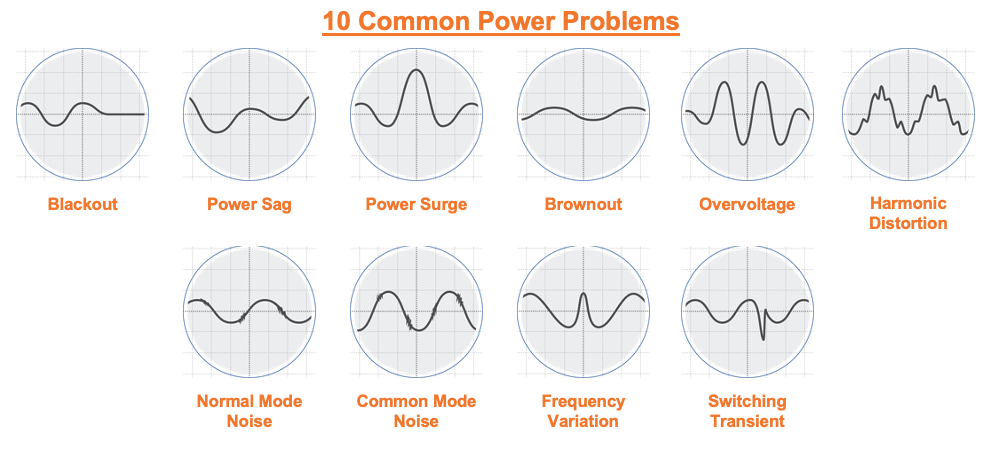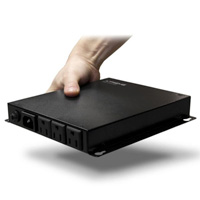An uninterruptible power supply, or UPS, is a critical component for audio-visual, security, networking and broadband installations. UPSs provide backup power when the main power source fails, they condition incoming power from surges and voltage fluctuations, and they optimize power output signals to perform within intended specifications.
In essence, UPSs ensure devices operate properly and efficiently with or without power from the main grid and they protect devices from damage and data loss.
In previous articles we’ve discussed the ten major power problems that affect residential and commercial buildings. In this article we’ll explore UPS technology, including the four major constructions — standby, line interactive, online and isolated online — and how they protect against different power issues. However, before we begin it’s helpful to understand key design considerations when selecting a UPS system.
Key Design Considerations
Several key design considerations influence the selection of an Uninterruptible Power Supply. Before purchasing any hardware, it’s important to understand the below factors.
Installation environment. UPS systems rely on a stable, dry environment with temperatures typically between 68 – 77 degrees F and 60% or less humidity. An environment outside of these parameters may shorten the UPS’s battery life and lead to noisy system operation (especially of the UPS features built-in fans for cooling). In addition, it’s important to understand the available footprint for the UPS hardware, including whether it will be rack-mounted, wall-mounted or free-standing in a dedicated cabinet.
Power environment. Within the United States, power infrastructures typically consist of alternating current (AC) in one of three configurations: single phase, dual (or split) phase and three phase. All three environments are different, as are the UPS systems required for them. Most residential systems use single or split phase, whereas larger commercial projects use three phase.
Power load and runtime. Power load (the power requirement of all the devices connected to the UPS) and runtime (the desired protection time for the total load) are also important factors when choosing a UPS system. It’s critical to choose a system that accounts for the total load and desired runtime, including a 20% overage to account for power spikes and future system expansion. If needed, Future Ready Solutions posted an article that walks through the calculation process.
Battery technology. All UPS systems require batteries, and battery construction will influence the system’s upfront and long-term cost, required maintenance and even environmental impact. Future Ready Solutions explores different battery types in an online article.
Modular vs. conventional. In addition to different construction and format technology, UPSs are also available in both modular and conventional (or single fixed unit) designs. Installations with tight budgets will typically benefit from the lower cost of a conventional UPS system, whereas installations that anticipate growth and depend on reliable long-term operation will benefit from a modular UPS design. Future Ready Solutions explains more in an a separate article.
Monitoring and remote management. Some UPS systems offer remote monitoring, management, diagnostics and alerts. Consider who will be managing and servicing the system over its installation life and whether remote functionality is required.
Power problem coverage. Different UPS constructions also address different power problems, as addressed in the 10 Common Power Problems article. These problems include blackouts, brownouts, surges, sags, noise, power variations and power distortions that can damage electronics and affect their performance. The different UPS types — standby, line interactive, online and isolated online — all protect against different problems.

Good: Standby UPS Systems
Now that we understand the design considerations when choosing a UPS system, let’s explore the four major constructions beginning with the most basic (and also least expensive) technology: standby UPS protection.
Standby UPS systems are designed to provide short term power to localized devices. They are commonly used for single workstations and single equipment racks, and should never be used with critical devices. This is because, unlike other UPS formats, standby UPSs don’t provide constant protection for connected devices and rely on an inverter switchover in the event of power failure.
Devices plugged into an standby UPS receive power directly from the power grid rather than the UPS’s inverter output. The inverter, which converts the battery’s DC power to AC, is “offline.” When the power fails, the standby UPS automatically connects the device’s load to the inverter’s output, which can take up to 10 milliseconds or more.
Due to this construction design, standby UPSs are typically less efficient, have shorter battery life and only protect against blackouts, power sags and limited power surges.
Better: Line Interactive UPS Systems
Unlike standby UPS systems, line interactive systems keep the DC-to-AC power inverter “inline” with the UPS’s output. When the power grid is functioning normally, the inverter is in AC-to-DC mode to charge the battery. When the power grid fails, the UPS’s transfer switch opens and the inverter reverses allowing the battery to power the connected devices.
Because the inverter remains active, line interactive UPS systems provide expanded protection against five of the common power problems: blackouts, power sags, power surges, brownouts and overvoltage.
Line interactive UPSs also offer improved battery life and are typically used for network servers, small residential and commercial systems and more critical devices.
Explore line interactive UPS solutions
Best: Online (Double Conversion) UPS Systems
Also known as double conversion technology, online UPSs provide constant and enhanced power protection against normal mode noise, harmonic distortion, switching transients and frequency variations.
This zero transfer time and enhanced filtering functionality is due to the online UPS’s double conversion design: first a rectifier converts AC power from the power grid to DC power, which is stabilized and fed through an inverter that converts it back to AC power. When the main power source fails, the UPS automatically eliminates the rectifier to instantaneously switch to battery power. As a result, online UPSs provide long periods of battery runtime and provide maximum protection for highly sensitive electronics and connected equipment.
Best+: Isolated Online UPS Systems
Also known as power conditioned UPS systems or laboratory-grade UPS systems, isolated online UPSs combine power backup and enhanced conditioning into a single system.
Isolated UPSs expand upon the online design by filtering power through isolation transformers to ensure clean and stable power regardless of power grid fluctuations. Devices connected to an isolated online UPS are completely disconnected from outside power, and are therefore protected against all common power problems, including common mode noise.
Isolated UPSs are often used in mission-critical applications such as medical facilities, data centers, control rooms, industrial centers and any application with grounding or noise issues.
Explore isolated online UPS solutions


